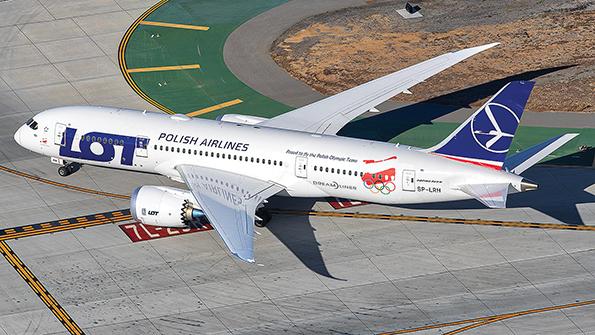
Maciej Wilk, LOT’s COO, talks with Lee Ann Shay about the Polish carrier’s fleet changes, sustainability efforts and outlook for increased international travel.
How are LOT’s fleet and operations adapting to the current environment?
Before the pandemic, we had 80 aircraft and today we have 75, so there wasn’t a drastic change. For leased aircraft, we focused on lease concessions instead of short-term deferrals or payment waivers—making the rates more flexible and dependent on use. This is better from a long-term perspective because we believe that once air traffic comes back, there will be a huge overcapacity in the market, and price competition will be more intense than in the past. Therefore, airlines will need to find effective cost reductions. In exchange for lessors’ concessions, we are offering lease extensions.
Did your maintenance reserves change too?
The majority of maintenance reserves are based on actual utilization—so it’s based on flight cycles or flight hours, APU flight hours, etc. With lower aircraft utilization, maintenance reserves came down drastically. And, of course, there are some fixed portions of maintenance reserves paid each calendar month, but they are not that significant. So it wasn’t much of an issue for us.
And are you planning on making any changes in the next year? Are there any investments that you’re considering?
When you look at some of the best aircraft deals ever made, these were made in the midst of a crisis. The future winners make important decisions regarding their fleets for the future, which we are trying to do. We do have to recognize that European green policies, in the very near term, will require operators to phase out older-generation jets and introduce more fuel-efficient ones that emit less CO2.
As the largest Embraer operator in Europe, with 37 aircraft, and with Q400s as well, we know that all of these aircraft will have to be removed from our fleet within the next couple of years. So we’re talking about 49 aircraft as of today. We are planning how to remove these aircraft from our fleet and gradually replace them with newer-generation aircraft. That’s a tremendous project. But it’s definitely something that’s required because we need to become more fuel efficient and more environmentally friendly.
Which jets are you considering?
We have identified two options—one being the Embraer E2, which would make a lot of sense because we are one of the largest European Embraer operators. The other is the Airbus A220, because it’s a great aircraft for passengers, and it offers flexibility due to the variants. We’re in talks with both providers and are analyzing our options.

Are you getting what you need from the aftermarket?
Communication with aftermarket service providers often takes longer than usual because not all companies have staff working full-time, regular hours. This is definitely something that we would like to see improved. But once we start actually meeting again in person, it should get better. Many providers are still very strict about meeting in person, but the ones that are responsive and actually meet with us have an advantage, because meeting in person is just a better way of doing business.
People are born to interact with each other. And the greatest ideas come to light based on interaction.
Is LOT experiencing any supply chain issues?
We are not experiencing significant problems. And we have good third-party provisioning programs from our key suppliers, and the pools that we’re using are located relatively near the U.S. and in Europe. But there are cases, for example, where we need to replace a number of seat tables. The factory is closed until the end of September, and I was told that I will get my tables in October. Seat tables do not cause AOGs, but it lowers passengers’ comfort, which is bad.
Which companies do you use for provisioning and pools?
We have a number of agreements, including good cooperation with KLM. We also have a pool agreement with Ember.
When do you expect to get back to a full international travel schedule for passengers?
I agree with the market forecasts that predict the whole global market will come back to 2019 levels in 2024. However, I think that the recovery will differ among the various regions. And I strongly believe that central Eastern Europe, where I am, will recover faster than many other regions. Our ambition is to return to 2019 levels in 2023.
What are the biggest lessons learned from the pandemic so far? What operational resiliency measures is LOT taking?
One of the key lessons is that force majeure can actually occur. That clause appears in many contracts, but I’ve never seen it used before. In the past year, the whole world was in force majeure. That’s an important lesson for every airline, in that grounding a significant part of an operation can occur, and unfortunately, now that it has been imposed in 2020, I think that it will be easier for governments to impose some kind of restrictions whenever they see fit to do so. The most important lesson for airlines is that operating on a fixed-price basis is just too big a risk—the key is to make as many costs variable as possible, from fuel to fleet costs. I know that this is pretty basic stuff. But when traffic stops, you are left with millions and millions in costs that you are required to pay each month, and you have no way to cover these kinds of expenses from your liquidity.
You touched on sustainability as one of the drivers that is making you reevaluate your regional aircraft. Are there other sustainability-related steps that you are taking or are considering?
It’s in the best interest of every airline to save as much fuel as possible. Each ton of fuel saved by the airline means saving 3 tons of CO2. So, we undertook a number of initiatives way before the pandemic to promote fuel-saving practices among our crews. We promote single-engine taxiing in and out. We also consider how we plan flights, and we do a deep analysis about aircraft weight and how can we limit it. Of course, we are also very active in the European discussion about Single European Sky because we believe that this is a great idea that should finally come to life. A Single European Sky would allow airlines to emit about 10% less emissions in Europe simply by having proper coordination between countries’ navigation centers.
